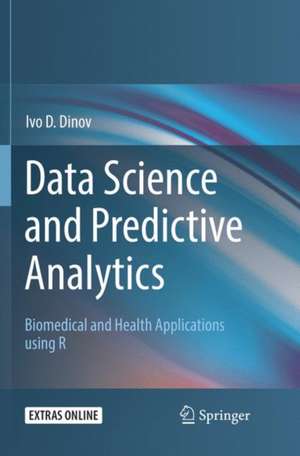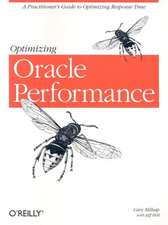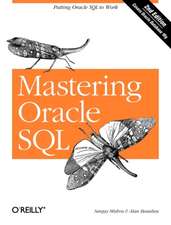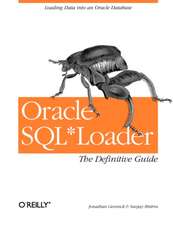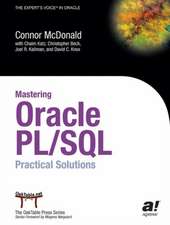Data Science and Predictive Analytics: Biomedical and Health Applications using R
Autor Ivo D. Dinoven Limba Engleză Paperback – 25 ian 2019
The content of this graduate-level textbook fills a substantial gap in integrating modern engineering concepts, computational algorithms, mathematical optimization, statistical computing and biomedical inference. Big data analytic techniques and predictive scientific methods demand broad transdisciplinary knowledge, appeal to an extremely wide spectrum of readers/learners, and provide incredible opportunities for engagement throughout the academy, industry, regulatory and funding agencies.
The two examples below demonstrate the powerful need for scientific knowledge, computational abilities, interdisciplinary expertise, and modern technologies necessary to achieve desired outcomes (improving human health and optimizing future return on investment). This can only be achieved by appropriately trained teams of researchers who can develop robust decision support systems using modern techniques and effective end-to-end protocols, like the ones described in this textbook.
• A geriatric neurologist is examining a patient complaining of gait imbalance and posture instability. To determine if the patient may suffer from Parkinson’s disease, the physician acquires clinical, cognitive, phenotypic, imaging, and genetics data (Big Data). Most clinics and healthcare centers are not equipped with skilled data analytic teams that can wrangle, harmonize and interpret such complex datasets. A learner that completes a course of study using this textbook will have the competency and ability to manage the data, generate a protocol for deriving biomarkers, and provide an actionable decision support system. The results of this protocol will help the physician understand the entire patient dataset and assist in making a holistic evidence-based, data-driven, clinical diagnosis.
• To improve the return on investment for their shareholders, a healthcare manufacturer needs to forecast the demand for their product subject to environmental, demographic, economic, and bio-social sentiment data (Big Data). The organization’s data-analytics team is tasked with developing a protocol that identifies, aggregates, harmonizes, models and analyzes these heterogeneous data elements to generate a trend forecast. Thissystem needs to provide an automated, adaptive, scalable, and reliable prediction of the optimal investment, e.g., R&D allocation, that maximizes the company’s bottom line. A reader that complete a course of study using this textbook will be able to ingest the observed structured and unstructured data, mathematically represent the data as a computable object, apply appropriate model-based and model-free prediction techniques. The results of these techniques may be used to forecast the expected relation between the company’s investment, product supply, general demand of healthcare (providers and patients), and estimate the return on initial investments.
| Toate formatele și edițiile | Preț | Express |
|---|---|---|
| Paperback (2) | 426.23 lei 38-44 zile | |
| Springer International Publishing – 25 ian 2019 | 426.23 lei 38-44 zile | |
| Springer International Publishing – 17 feb 2024 | 536.96 lei 38-44 zile | |
| Hardback (1) | 741.66 lei 6-8 săpt. | |
| Springer International Publishing – 17 feb 2023 | 741.66 lei 6-8 săpt. |
Preț: 426.23 lei
Preț vechi: 532.78 lei
-20% Nou
Puncte Express: 639
Preț estimativ în valută:
81.56€ • 85.38$ • 67.48£
81.56€ • 85.38$ • 67.48£
Carte tipărită la comandă
Livrare economică 01-07 aprilie
Preluare comenzi: 021 569.72.76
Specificații
ISBN-13: 9783030101879
ISBN-10: 3030101878
Pagini: 832
Ilustrații: XXXIV, 832 p. 1443 illus., 1245 illus. in color.
Dimensiuni: 155 x 235 x 47 mm
Greutate: 1.41 kg
Ediția:Softcover reprint of the original 1st ed. 2018
Editura: Springer International Publishing
Colecția Springer
Locul publicării:Cham, Switzerland
ISBN-10: 3030101878
Pagini: 832
Ilustrații: XXXIV, 832 p. 1443 illus., 1245 illus. in color.
Dimensiuni: 155 x 235 x 47 mm
Greutate: 1.41 kg
Ediția:Softcover reprint of the original 1st ed. 2018
Editura: Springer International Publishing
Colecția Springer
Locul publicării:Cham, Switzerland
Cuprins
1 Introduction.- 2 Foundations of R.- 3 Managing Data in R.- 4 Data Visualization.- 5 Linear Algebra & Matrix Computing.- 6 Dimensionality Reduction.- 7 Lazy Learning: Classification Using Nearest Neighbors.- 8 Probabilistic Learning: Classification Using Naive Bayes.- 9 Decision Tree Divide and Conquer Classification.- 10 Forecasting Numeric Data Using Regression Models.- 11 Black Box Machine-Learning Methods: Neural Networks and Support Vector Machines.- 12 Apriori Association Rules Learning.- 13 k-Means Clustering.- 14 Model Performance Assessment.- 15 Improving Model Performance.- 16 Specialized Machine Learning Topics.- 17 Variable/Feature Selection.- 18 Regularized Linear Modeling and Controlled Variable Selection.- 19 Big Longitudinal Data Analysis.- 20 Natural Language Processing/Text Mining.- 21 Prediction and Internal Statistical Cross Validation.- 22 Function Optimization.- 23 Deep Learning Neural Networks.- 24 Summary.- 25 Glossary.- 26 Index.- 27 Errata.
Recenzii
“Data Science and Predictive Analytics is an effective resource for those desiring to extend their knowledge of data science, R or both. The book is comprehensive and serves as a reference guide for data analytics, especially relating to the biomedical, health care and social fields.” (Mindy Capaldi, International Statistical Review, Vol. 87 (1), 2019)
Notă biografică
Dr. Ivo Dinov is the Director of the Statistics Online Computational Resource (SOCR) at the University of Michigan and is an expert in mathematical modeling, statistical analysis, high-throughput computational processing and scientific visualization of large datasets (Big Data). His applied research is focused on neuroscience, nursing informatics, multimodal biomedical image analysis, and distributed genomics computing. Examples of specific brain research projects Dr. Dinov is involved in include longitudinal morphometric studies of development (e.g., Autism, Schizophrenia), maturation (e.g., depression, pain) and aging (e.g., Alzheimer’s disease, Parkinson’s disease). He also studies the intricate relations between genetic traits (e.g., SNPs), clinical phenotypes (e.g., disease, behavioral and psychological test) and subject demographics (e.g., race, gender, age) in variety of brain and heart related disorders. Dr. Dinov is developing, validating and disseminating novel technology-enhanced pedagogical approaches for science education and active learning.
Textul de pe ultima copertă
Over the past decade, Big Data have become ubiquitous in all economic sectors, scientific disciplines, and human activities. They have led to striking technological advances, affecting all human experiences. Our ability to manage, understand, interrogate, and interpret such extremely large, multisource, heterogeneous, incomplete, multiscale, and incongruent data has not kept pace with the rapid increase of the volume, complexity and proliferation of the deluge of digital information. There are three reasons for this shortfall. First, the volume of data is increasing much faster than the corresponding rise of our computational processing power (Kryder’s law > Moore’s law). Second, traditional discipline-bounds inhibit expeditious progress. Third, our education and training activities have fallen behind the accelerated trend of scientific, information, and communication advances. There are very few rigorous instructional resources, interactive learning materials, and dynamic training environments that support active data science learning. The textbook balances the mathematical foundations with dexterous demonstrations and examples of data, tools, modules and workflows that serve as pillars for the urgently needed bridge to close that supply and demand predictive analytic skills gap.
Exposing the enormous opportunities presented by the tsunami of Big data, this textbook aims to identify specific knowledge gaps, educational barriers, and workforce readiness deficiencies. Specifically, it focuses on the development of a transdisciplinary curriculum integrating modern computational methods, advanced data science techniques, innovative biomedical applications, and impactful health analytics.
The content of this graduate-level textbook fills a substantial gap in integrating modern engineering concepts, computational algorithms, mathematical optimization, statistical computing and biomedical inference. Big data analytic techniques and predictive scientific methods demand broad transdisciplinary knowledge, appeal to an extremely wide spectrum of readers/learners, and provide incredible opportunities for engagement throughout the academy, industry, regulatory and funding agencies.
Exposing the enormous opportunities presented by the tsunami of Big data, this textbook aims to identify specific knowledge gaps, educational barriers, and workforce readiness deficiencies. Specifically, it focuses on the development of a transdisciplinary curriculum integrating modern computational methods, advanced data science techniques, innovative biomedical applications, and impactful health analytics.
The content of this graduate-level textbook fills a substantial gap in integrating modern engineering concepts, computational algorithms, mathematical optimization, statistical computing and biomedical inference. Big data analytic techniques and predictive scientific methods demand broad transdisciplinary knowledge, appeal to an extremely wide spectrum of readers/learners, and provide incredible opportunities for engagement throughout the academy, industry, regulatory and funding agencies.
Caracteristici
A novel transdisciplinary treatise of predictive health analytics Complete and self-contained treatment of the theory, experimental modeling, system development, and validation of predictive health analytics Unique collection of case-studies, advanced scientific concepts, lightweight tools, and end-to-end workflow protocols that can be used to learn, practice and apply to new challenges Includes unique interactive content supported by community of 100,000 R-developers Represents a blended STEM-Health Science approach to challenging biomedical problems Support reproducible science, transdisciplinary collaboration, and sharing
